P.C. Zick's Blog, page 3
April 15, 2025
WILD FOR FLORIDA WILDLIFE



“Why aren’t there any mosquitoes when I visit Florida?” I was once asked.
“Where do you go in Florida?” I asked.
“To Disney World, Sea World – all those theme parks around Orlando.”
I wondered how to reply without bursting this man’s image of “natural” Florida that exists within the gates of “unnatural” worlds made from the crumbs of a chopped up natural world and sculpted into the vision of a perfect living community.
The real Florida, buried under tons of asphalt in the majority of the state, does exist in random spots and clumps of preserved zones or land unfriendly to developers who have yet to figure out how to grab remaining wetlands and scrub forests to turn them into yet further replicas of what some would prefer to call “natural.”
People come to the Sunshine State for a week or more to soak up the sun and ride trains through wild lands with propped and stuffed bears, panthers, and alligators. How tranquil it all appears from the seat of a train. Twenty years later, after the kids are grown, they race south to live and become shocked when the first mosquito stings or a coyote eats their dog.
That’s the real Florida. New subdivisions are built on the edge of raw and natural wetlands and woods. People want to view the natural world, but often don’t want to be bothered by all the creatures that inhabit the last vestiges of wild land. Often the new developments disrupted the habitat of the wildlife further confusing the natural order of things.
[image error]Pexels.com" data-medium-file="https://pczick.com/wp-content/uploads..." data-large-file="https://pczick.com/wp-content/uploads..." src="https://pczick.com/wp-content/uploads..." alt="" class="wp-image-105025 size-full" />For several years, I worked in public relations for the Florida Fish and Wildlife Conservation Commission. One of my first assignments found me in Ft. Myers, Florida, in a subdivision that had recently been built adjacent to a wildlife preserve. Guess what? Coyotes, recently displaced, thought the cats and small dogs in the neighborhood were dinner.
One woman yelled at me to kill all the coyotes. She couldn’t understand that buying a home on the edge of a wild, natural area meant there would be wildlife whose natural habitat had just been cut in half.
The “wily” coyote earned its name based on its behavior. In wide-open expanses of land, the coyote roamed and only became a menace when attacking domestic livestock. Ranchers handled the situation. When the coyote found its environment disrupted, such as in Florida, the animal adapted. Space became a problem. Subdivisions encroached on rural areas, and the wily coyote adapted to become the urban coyote.
The same thing happens wherever habitat is disrupted. The wildlife doesn’t just walk away into the sunset to find a benevolent zookeeper where the public can see wildlife behind cage bars.
If the wildlife adapts, then so must we by respecting and enjoying wildlife from a distance. Coyotes adapted when humans fed them, which led the wild animal to associate humans with a dependable source of food, according to a report by the Florida Fish and Wildlife Conservation Commission. The coyote became aggressive and bold and led to attacks on humans, pets – leashed and unleashed – and livestock.
If you want to minimize your contact with wildlife – from bugs to alligators – buy a condominium or rent an apartment.
If you love nature but hate buzzing mosquitoes, watch the Discovery channel.

But if you understand the nuances of living with, yet separately, from wildlife, buy a home on the edge of wilderness and help educate others on how to live peacefully with wildlife. And don’t forget to buy a set of good binoculars and a camera with a zoom lens.

The three books in this series are stand alone reads but with similar themes–Florida and its wildlife, in human and animal form.
Each book is available in Kindle (free with Kindle Unlimited), paperback, and audio.
Click here to purchaseApril 8, 2025
SOPCHOPPY – SMALL TOWN BIG IN NATURE
 Sopchoppy River, Florida
Sopchoppy River, FloridaThe Worm Gruntin’ Festival first drew my eye to the small town of Sopchoppy, Florida, located between Tallahassee and the Gulf of Mexico. I had no idea what it was, but it sounded weirdly fun.
Worm Gruntin’ is an ancient technique to get earthworms up from the ground. A wooden stake—a “stob”—is pounded into the ground. Then the “grunters” use a length of iron to rub the top of the stake. This process creates a grunting sound underground and gets those worms riled up enough to come to the surface. During the festival, contestants in the contest create their own stakes and “roopin’” irons.
Locals often use this method to capture earthworms for fishing and then sell them to area bait shops. And there are many of those for good reasons. There are ample opportunities for fishing all around the small village.
So, what better way to bring more tourists to town and to honor this old tradition? Start a festival, which features a contest for worm grunters, vendors, music and at the end of the day a Grunters’ Ball with live music and dancing at the Civic Brewing & Pizza Co.
 April 12, 2025
April 12, 2025Begun in 2001, the festival has been featured on national television and has made the town famous. This year’s event happens on Saturday April 12 with the contest and 5K run happening early in the morning. The entire event is free and open to the public.

The water and its excellent opportunity for fishing brings folks to Sopchoppy, which is located on the eastern bank of the Sopchoppy River as it flows to the nearby Ochlocknee River shortly before it widens and becomes Ochlocknee Bay and empties into the Gulf.
Tourists come from around the world to fish in the nearby fresh and salt waters. We kayaked a small portion of the Sopchoppy River recently. We launched from the City Park and paddled upstream for three miles before turning around. The current is slow in this section with several sharp turns. At the headwaters, the river is a squiggly line on the map. As it goes further downstream from the town, it widens and can be effected by the tides from the Ochlocknee.
On our little two-hour excursion, we saw only a handful of houses and passed two other kayakers. The wild azaleas were in full bloom, which created a beautiful and peaceful respite from the crazy world.


When we finished, we developed a mighty thirst, so thank goodness for the Civic Brewing & Pizza Co. in the downtown area across from city hall, which opened in 2021. It’s been a great addition to Sopchoppy.
Elliot Seidler and his sister, Taylor Seidler, are both Sopchoppy natives who left home as young adults—him to the Navy and her to Boston—when their paths converged on the craft brewery concept. They could have gone anywhere to start it, but they chose to come home. And I for one am happy they did! Every beer we’ve enjoyed there has been top notch. I even tried something way out of my usual tastes after the kayak trip—a white chocolate vanilla wit. Still smacking my lips.
And on April 12, it will host the Grunters’ Ball after all the excitement of the Worm Gruntin’ Festival. Life is good in Sopchoppy, Florida.




Tortoise Stew by P.C. Zick
A wild and raucous ride through the crazy world of small town Florida politics. Political satire filled with murder, mystery, suspense, and vengeful antagonists. And women who fight from home and the workplace.
Available in Kindle (free download with Kindle Unlimited), paperback, and audio.
Click here for more informationApril 1, 2025
FOR THE LOVE OF SEA TURTLES
I’ve long had a love affair with sea turtles. It might have started when I learned the amazing life history of this species. It only grew after my experience first as a volunteer member of a sea turtle patrol on Matanzas Beach, Florida, twenty years ago. Then fifteen years ago, I was a part of a team tasked with saving sea turtles from the tar balls on Florida’s Panhandle coast in the months after Deepwater Horizon in my job with Florida Fish and Wildlife Conservation Commission (FWC).
 Loggerhead sea turtle
Loggerhead sea turtleSea turtle nesting season has begun in Florida. In March, along Florida’s southeast Atlantic coast from Brevard County south to Broward County, they begin the nesting process. Nesting begins on the Gulf Coast or north Florida beaches in April or May. Because Florida’s shorelines provide important nesting habitat for several species of threatened and endangered sea turtles, beachgoers can impact either he success or failure of the nests. Once the eggs are laid, it’s a waiting game until they hatch later in the summer and fall. But first those nests need to be protected on Florida’s busy beaches. If you visit Florida’s coast from March through November, please follow the guidelines from FWC—listed at the end of this post—for ensuring a successful birthing season for these special animals. But first, here’s my story of the early stages of my burgeoning love.
Several years ago, I gave birth to a sea turtle on Matanzas Beach on Florida’s Atlantic Coast. Well, not literal birth, but I helped a hatchling go to the sea.
(Photo from 2005, P.C. Zick)

Volunteering as a sea turtle patroller requires walking the beach before 7 a.m. By the end of the summer, many of the volunteers have decided it is too much. The staff who run the sea turtle program call those of us who make it through the entire season the “dedicated ones.” To me, the reward for the early walks would pay off once the hatchlings emerged later in the summer, so I stayed for the whole season.
One morning in June 2005, I walked alone on the beach near the Matanzas Inlet. My patrol partner walked the north end of the beach, nearer St. Augustine. We carried our cell phones to call in reports and a stick to mark potential nests. That morning, I noticed a pattern of swishes in the sand, starting at the tide line and heading toward the dunes, but the patterns looked small for the flippers of the loggerhead, which is the more common of the sea turtles in Florida. They can weigh up to 275 pounds. I walked away without leaving my stick, but as I continued my patrol, I knew nothing could have left marks in the sand in such symmetry. I called the office, reported its location and placed my stick in the sand so the biologists would be able to find it. Later it became a confirmed nest. Matanzas North Nest #3 may have been the official title, but from that day forward, I thought possessively of it as mine.
After seventy days of incubation passed, the biologists decided it was time to dig up the nest to see if any of the eggs were viable. Fortunately, they remembered to call me to witness the process. They had barely scratched the surface when they found a hatchling. It barely moved at first, and the biologist conducting the dig put it in a box of wet sand until it starting moving around in the sand.
They continued digging and eventually found the remains of 120 hatched eggs and four eggs that had gone bad. These are pretty good statistics, but there is no guarantee all 120 of the hatchlings made it to the sea. Those of us gathered on the beach kept all predators away from this lone straggler, but the other hatchlings didn’t have that protection when they emerged, mostly likely the night before.


When the hatchling began moving around in the box, a volunteer placed it on the sand next to the nest so it might remember the precise location of emergence. If this one turns out to be a female, in approximately thirty years this same turtle most likely will come ashore at Matanzas and lay its first batch of eggs. The scientists believe the turtles tap into the Earth’s magnetic field while in the nest.
“My baby” sea turtle began its long walk to the sea following its instincts. A group of high school biology students formed a protective circle with the rest of us. Morning visitors to the beach, along with their vehicles, already competed for space. We left our baby a wide berth, so nothing could impede its determined yet slow walk to the sea.
As the tide receded, the hatchling encountered some difficulty when the first wave hit it, but it knew just what to do—it just didn’t have the strength yet to swim out far enough not to be swept back in. Repeatedly, we watched as it attempted to go back into the ocean. We cheered each time it managed a ride and commiserated each time we saw it come back toward us.

“Watch your feet,” one of the biologists yelled when the wave swept the hatchling back toward those of us forming its shield.
Barely two-inches long, this baby looked no bigger than the sack of eggs left by sharks on the beach. The hatchling tried again, this time managing a five-foot entry into the sea, only to be swept back onto the beach again.
And then a big wave came as we cheered, but “my baby” came back near my feet—belly up. The soft under belly, black and white spotted, faced me as its flippers frantically tried to right itself.
One of the biologists picked it up, walked out into the ocean for more than ten feet, and let the sea turtle go into its world undersea.

In one hour, this baby had been pulled from the sand, crawled for the first time and then swam away to fend for itself in the sea. We had done all we could to protect it. The rest was up to nature and the sea grasses will protect it in the coming years.
“Safe passage,” I whispered.
Luckily, the Deepwater Horizon oil spill was five years away, so maybe this little hatchling made it before the tarballs entered its habitat. The story of my role in protecting those nests will have to wait for another post.
For now, if you go to either coast of Florida from March through November, please follow the guidelines set by the Florida Fish and Wildlife Conservation Commission. And if you see either the female coming ashore to lay its eggs or hatchlings emerging later in the summer and fall, give them space and keep others away from them.
Guidelines for BeachgoersLights out – Any lighting can misdirect and disturb nesting sea turtles and their hatchlings, leading them away from the ocean and toward potential danger. To prevent this, beachgoers should use natural starlight to see while on the beach at night and avoid using flashlights or cellphones. Anyone living along or visiting Florida beaches can do their part by putting porch, parking or deck lights out when not in use and closing curtains after dark to avoid disorienting nesting and hatchling sea turtles on the beach.Admire from afar – While it can be exciting to witness sea turtles on the beach, getting too close (50 feet or less) to nesting sea turtles can cause them to leave the beach before they complete the nesting process. If an animal changes its behavior, you’re likely too close. Remember – it is illegal to harm or disturb nesting sea turtles, their nests and eggs, or to pick up hatchlings.Clear the way at the end of the day – Female sea turtles expend large amounts of energy crawling out of the surf and far enough up the sand in order to dig and lay nests in spots that are less vulnerable to the tides. Obstacles on the beach can entrap and prevent them from nesting as they crawl across the sand to lay their eggs. Trash, holes in the sand and other obstacles can also prevent sea turtle hatchlings from reaching the water once they emerge from their nests. Food scraps attract predators, such as raccoons and crows, that prey on sea turtle hatchlings. Litter on beaches can entangle sea turtles, birds and other wildlife. Properly stash or recycle all trash, fill in man-made holes in the sand, and remove all beach toys, gear and furniture from the sand before sunset. Fishing line can be deadly to sea turtles, waterbirds, and other wildlife, so be sure to dispose of it properly.For more information about nesting sea turtles and how you can help, visit the . Report any sea turtles that appear sick, injured, entangled or dead to the FWC’s Wildlife Alert Hotline at 888-404-FWCC (3922). Florida Fiction by P.C. ZickKindle, paperback, audio click here
Florida Fiction by P.C. ZickKindle, paperback, audio click here
March 25, 2025
MY MOVIE DEBUT – WATER’S JOURNEY
I met Wes Skiles, a cave diving pioneer, explorer, and underwater cinematographer, soon after moving to High Springs, Florida. He also lived in High Springs. His business, Karst Productions, was based outside the small town.

His photographs of the springs and caves, not only of caves and springs in the High Springs area, but also worldwide, had been published in National Geographic. He was a rock star locally, and I was in awe of the dude and all he did. Yes, he was known nationally and internationally for his photography and filmmaking and underwater discoveries, but he also never lost his loyalty and passion for the first springs he ever visited as a young child. He loved them so much that he moved from Jacksonville to High Springs and raised his family near the Ichetucknee and Santa Fe rivers.
I worked for a decade as a reporter for several local publications. I often wrote about the rivers and springs in the area, and without fail, Wes never turned me down for an interview despite his growing fame. He would even provide me with photos if I wrote about the ecology and conservation of his beloved springs. I last interviewed him in 2010 a few months before he died tragically and suddenly in an underwater photo shoot for National Geographic in South Florida.
During that last interview he described for me the course his life took. “The springs were the first truly magical place I explored as a child,” Skiles said. “We first went to Ginnie Springs [on the Santa Fe River], and I was totally mesmerized and consumed. I never had any doubt—even at that young age—that I was going to do everything in my power to keep coming back to the springs.”

In 2001, Wes and his crew began filming his series Water’s Journey – The Hidden Rivers of Florida and asked my then-husband, Larry, and I if we would be a part of the film as homeowners who were taking conservation measures in our home.
When the film crew first showed up at my house on September 29, 2001, I was not enthusiastic about the production. I became even more disillusioned when my thirty-second movie debut took all day to film.
I am not sure what I expected that Sunday morning when they came to our house. I thought it would be just Wes and a guy with a camera who Wes would direct. When we offered Wes coffee he said, “I’m sure the crew would love some.”
That was my first clue that this was no small production.
After the crew of eight dismantled my living room and kitchen, I recognized very little of my home. In the film, I could identify things I owned, but they were placed in different spots for effect.
 Living Room Redux
Living Room ReduxI went upstairs to put on make-up and dress for my role as homemaker. I thought with my blonde hair, black would make a nice contrast. When I arrived on the “movie set,” AKA, my living room, the head camera guy started yelling in what sounded like a French accent. “She’s too white; she’s too white!” he screamed.
I’ve always been white, but I never had anyone shout about it. Wes saw the look on my face—picture a deer in the headlights of a car—and threw his head back in laughter.
“He means the black shirt and your hair are creating too much contrast for the camera,” he told me. “Can you put on something lighter?”
I changed into a beige cardigan set and came back down even less excited about my “acting” debut.
During the filming, Larry spoke passionately about his reasons for conservation, and I provided the June Cleaver role. It starts with me waiting patiently for my husband’s return from a hard day of work—in my beige cardigan—and truly acting because I am not generally a patient person nor did I await his arrival at home so I could wait on him.
“Would you like a glass of water?” I asked as I stood waiting for him in the kitchen.
I asked him more than thirty times before it was announced that I had it just right. I was really acting at that point because I was ready to throw the damn glass at somebody, probably the camera guy who announced my whiteness to the world. As I poured from the jug, I had to hold my arm and wrist at the weirdest angles, so they could capture the water escaping the pitcher into the glass.
As weird as the whole thing felt to me, the result was well worth the pain of acting like the perfect housewife. The movie’s message resounds with common sense reasons why we all need to be aware that our actions impact the very water we drink, not just today, but for the long-term future.
 My Acting Debut
My Acting Debut The movie turned out to be the first of a series of documentaries about water produced by Wes and his partner at Karst Productions, Jill Heinerth.
The finished production follows a group of explorers as they trace water’s journey through caves, springs, rivers, wetland estuaries, and coral reefs. It even takes the explorers through a Sonny’s Barbecue restaurant in Alachua, Florida. Done with a touch of humor it brings together all the elements of water’s course and importance. And it even shows me gracefully pouring a glass of water from a pitcher in my beige top and still white face.
More than two decades later, the film is still being shown and used as a teaching tool in schools across the country. And I’m still waiting for my Oscar nomination.
Water’s Journey was shown on PBS where it won an award for a documentary series. It is also available on DVD.
Wes may have left this world in 2010, but his legacy endures. In 2011, the Florida State Park system renamed Peacock Springs on the Suwannee River in his honor. West Skiles Peacock Springs State Park is a 733-acre park honors Wes for “his documentary filmmaking, springs advocacy, and contributions to cave exploration.

In 2018, Julie Hauserman, Florida journalist, published Drawn to the Deep – The Remarkable Underwater Explorations of Wes Skiles.
It is a thorough look at the talent and passion of Wes and features interviews with his colleagues, friends, and family. Excerpts from his journal throughout his extraordinary and too short life paint a lasting impression of how much one person can accomplish.
My book about Ichetucknee Springs features interviews with Wes Skiles who loved to talk about the springs and rivers of north Florida even though his explorations took him around the world.
Download ebook for freepurchase paperback
March 18, 2025
SMALL TOWNS ROCK – PALATKA, FLORIDA


Any discussion about the Florida town of Palatka begins and ends with the St. Johns River, which helped create the community centuries ago. Back in its golden days, many called it the “Gem City of the St. Johns.”
The St. Johns River flows for 310 miles northward, making it Florida’s longest river. It begins in the swamps west of I-95 and Vero Beach on the eastern side of the state. The slow-flowing river takes a sharp turn east as it nears Palatka. The Palatka Memorial Bridge rises high above the river and leads to the highways connecting interior Florida to the coast. A “Spirit of the American Doughboy” statute stands guard at the base of the western side of the bridge.
Today, the river town is reinventing itself as a tourist destination not far from St. Augustine. And in the rejuvenation, both its history and the river play important roles. The name Palatka comes from a Native American word “Pilaklihaha” or “Pilotaikita,” which means cow ford or crossing. Before the invasion of the Spanish, the Timucuans split their time between the lush lands surrounding the St. Johns and the lush ocean for its variety of sea food. They enjoyed the benefits of both worlds.
After the Spanish arrived, they developed Palatka, Gainesville, and Tallahassee as major ranching areas, but the cattle from those places had to cross the St. Johns River because on the eastern side, St. Augustine housed the slaughterhouses. Cows, as its original name implies, could ford the river at Palatka.
But it was during the 1800s and during much of the Gilded Age that Palatka thrived, rivaling only Jacksonville on the east coast. When Florida became a U.S. territory in 1821, developers began eyeing central Florida. From Mayport north of Jacksonville, the large ocean vessels would venture southward on the St. Johns. The furthest south they could travel on the river was Palatka. For the next sixty plus years, prosperity reigned as military installments and steamboat lines boosted the status of the city. The wharves installed on the western side of the river could hold up to forty large ships. And during this time, it became the hub of Florida’s citrus industry. The Bronson-Mullholland House, built in 1860, showcases one of the city’s most prominent homes during this time. It is open for visitors every Saturday from 1 p.m. to 4 p.m. as well as on the first Sunday of the month from 1 p.m. to 4 p.m.
Two things occurred before the end of the century that changed the trajectory of the place once known as the “Gem City of the St. Johns,” thus ending its golden age.
First, railroads began replacing the steamships as they progressed into the interior of Florida. It was easier and faster to send goods on the trains. Then two years of devastating freezes wiped out the citrus farmers in the area around Palatka. Either Palatka could become a ghost town, or it could reinvent itself.
Industry became the savior when the Wilson Cypress Company established itself in Palatka in 1889. It eventually became the largest cypress mill in the world. Today, the main employer in Putnam County is Georgia-Pacific, a paper mill, which opened in 1947. For years, whenever I thought of Palatka it came with the smell of sulfur, one of the byproducts of paper mills.

Fortunately, I have gained a better appreciation of the town’s location and have enjoyed watching its revitalization. We stayed at a hotel that faces the river and adjoins to the riverwalk, which crosses under the bridge and over the river and leads to Riverfront Park. Along the way, we passed the Doughboy Statute and memorial to the infantry soldiers of World War I, and a sculpture created from a sketch by William Bartram who traversed the area in 1774 and stayed with the Timucuans for several months.





Walking away from the river toward the city center, the old buildings are adorned with murals depicting the history of the town. This walk leads directly to one of my favorite places, Azelea City Brewing Company, located in the old Coca-Cola bottling plant on 7th Street. The variety and quantity and quality of beer is astounding. They also host lots of community events, which makes it a popular local gathering place.
 Azalea City Brewing Co. in the old Coca-Cola Bottling plant
Azalea City Brewing Co. in the old Coca-Cola Bottling plantAlso, a visit to Ravine Gardens State Park, located within the city limits provides another glimpse of history when the CCC went to work during the depression creating walkways, fountains and gardens at this lovely spot that comes alive in the spring with an abundance of azaleas. And every February, the city hosts the Florida Azalea Festival with lots of activities and music at Riverfront Park.
I’ve traveled to many places in Florida and feel I’m quite knowledgeable about wildlife and the environment, but on my recent visit to Palatka, I learned something new. When I saw folks out on the piers and wharves casting nets into the water all through one warm September night , I was curious as to what they were doing. Turns out, shrimp come into the St. Johns at Mayport and head south starting in late August and sometimes continue into November. What I witnessed was a form of saltwater shrimping out of a freshwater river. Even better, other fish such as redfish and flounder follow them. I had never heard of this phenomenon until this visit.
Exploring the small towns of our country shows us history, culture, and ecology without much expenditure or effort. And in most of these towns, parking is still free!
 A rainy day in Palatka is still filled with sunshine!
A rainy day in Palatka is still filled with sunshine!
March 11, 2025
ICHETUCKNEE SPRINGS – A HISTORY AND CULTURE OF A FLORIDA SPRING – #FREE

A Project of the Heart
Please download my new book, Ichetucknee Springs – A History and Culture of a Florida Spring.
It’s #Free to download in any format that works for you. Click on the cover or here.
Ichetucknee Springs – A History and Culture of a Florida Spring – my latest project offers a glimpse into one of Florida’s natural gems. In north Florida less than an hour from the University of Florida, the Ichetucknee River is formed from the first-magnitude flow from eight-named springs.
I originally wrote this book in 2003 as Old Timers Remember – Ichetucknee Springs under the direction of Jim Stevenson, then chief biologist with Florida’s Department of Environmental Protection and expert on the springs of Florida.
For the past several years, I’ve wanted to update the book but could not find the digital copy used to print the book. I was the only one with those files. When someone approached me about the book, I decided it was time to redo the whole thing. So I digitized, edited, researched, and redid the whole thing and now to support the organizations who work tirelessly to protect the Ichetucknee and the other springs of Florida, I am offering the ebook version for free downloads.
Here’s a sampling from the book.

INTRODUCTION
When I moved to north Florida from Michigan in 1980, I had no conception or knowledge of the springs. To me, a spring was a little bubbling bit of water that might be found in the Upper Peninsula on an ice-cold river.
So, discovering the three rivers near where I had moved outside of High Springs came as a revelation. The slow-moving Santa Fe River was nothing like the fast and twisty rivers of the north. The wide Suwannee River with its dark tannic color and sandy banks—sometimes almost cliff-like—provided another surprise. But perhaps the lifesaver and most surprising came when I tubed down the Ichetucknee River on a hot August day my first summer in the south. Just when I began wondering how I would ever survive living in heat and humidity like nothing I’d ever experienced, I jumped into an innertube at the north entrance of the state park and melted into the 72-degree water and forgot all about leaving the south. It then became the ritual of summer for my family and me and gave us at least one day of respite while enjoying the unparalleled beauty of the clear water, eel grass, and sunning turtles of the Ichetucknee.
And then I met Wes Skiles, a cave diving pioneer, explorer, and underwater cinematographer, who also lived in High Springs. His sense of wonder and respect for the waters of my new home inspired me. I was in awe of the dude and all he did. Yes, he was known nationally and internationally for his photography and filmmaking and underwater discoveries, but he also never lost his loyalty and passion for the first springs he ever visited as a young child. He loved them so much that he moved from Jacksonville to High Springs and raised his family near the Ichetucknee and Santa Fe rivers. He located his business, Karst Productions, in High Springs.
I worked for a decade as a reporter for several local publications. I often wrote about the rivers and springs in the area, and without fail, Wes never turned me down for an interview. He would even provide me with photos if I wrote about the ecology and conservation of his beloved springs. I last interviewed him in 2010 a few months before he died.
He described for me the course his life took. “The springs were the first truly magical place I explored as a child,” Skiles said. “We first went to Ginnie Springs [on the Santa Fe River], and I was totally mesmerized and consumed. I never had any doubt—even at that young age—that I was going to do everything in my power to keep coming back to the springs.”[1]
In 2003, Wes Skiles approached me about writing a book for the Florida Department of Environmental Protection. Jim Stevenson, then chief biologist with FDEP, wanted to pull together all the oral and written histories he’d been collecting from a group called the Old Timers, consisting of folks who had lived near and enjoyed Ichetucknee Springs before it became a state park in 1970. Under Stevenson’s direction, I wrote Old Timers Remember – Ichetucknee Springs in 2003, using audio tapes and letters from this group. I then researched the history, geography, ecology, and cultural aspects of the Ichetucknee to round out the book. The little book that I wrote and published, with Stevenson’s direct input and editorial assistance, was sold at the state park. We printed a limited number of copies. I only have one myself and one printer’s proof.
When I was approached recently to provide an electronic copy of the book, I realized that in the twenty-two years since I pulled this project together that the copies on the old zip drive disks no longer existed. I had no files electronically anywhere of the manuscript or photos. When I looked back over my copy of Old Timers Remember, I realized it really needed to be updated and edited.
As a result, I present Ichetucknee Springs – A History and Culture of a Florida Spring. I was able to scan the maps drawn by Larry Behnke for the first book. Thank you, Larry.
A debt of gratitude to the work and dedication of Jim Stevenson. His love of the rivers and springs of Florida has helped bring awareness and has pointed the way for all residents to be wise stewards of the place where we live. His book, published in 2014, My Journey in Florida’s State Parks: A Naturalist’s Memoir, chronicles his experiences with the state park system in Florida from 1965 onward. Thank you, Jim.
[1] Patricia Behnke [AKA P.C. Zick]. “Saving Florida’s springs one drop at a time.” Florida Wildlife. July/August 2010.
Download #Free Ebook
March 4, 2025
SMALL TOWNS ROCK
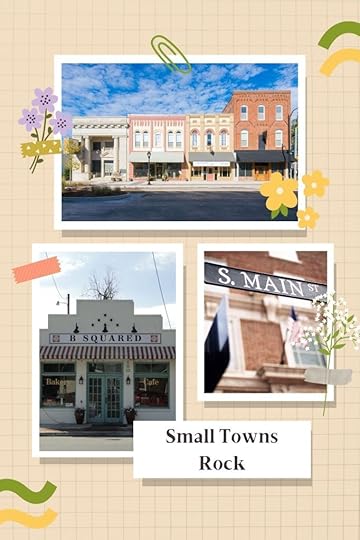
Small towns form the backbone of our country where farming and culture met and flourished for the first centuries of our existence. Railroads and interstates nearly destroyed them, but with the resilience of strong foundations, they have begun the slow process of bringing us together once again. Revitalization efforts across the country are bringing back the history and the charm of simpler times while claiming some of the elements of our current culture. Antique stores stand next to modern home furnishing glitz.
Throughout my life, I’ve abhorred, abandoned, and adored—and in that order—the small villages that dot the landscape. Now I find it fascinating to study their history because it really is the history of the United States of America.
I was born in a small Michigan town with a population of 1,100. Today, seventy years later, that village still boasts nearly the same population. I hated living there at the time. Isolated in winter, filled with hypocrites flaunting wealth and gossip all the while praying to the good Lord in church each Sunday. I couldn’t wait to leave and move to Ann Arbor approximately thirty miles away.
By the time I turned eighteen and graduated from high school, the door wasn’t hitting me in the back because I’d flown out of it the moment I graduated from high school. After seven years of “big city” life, my first husband and I escaped Michigan and traded our culturally rich life and debilitating winters for a small town in north Florida. I loved everything about this small town—a place that didn’t know my history or my family. We embraced living there and participated as leaders in the revitalization in the town that had been abandoned when tobacco no longer reigned in the south. And we had another university town, Gainesville, just down the road twenty miles. We had it all.
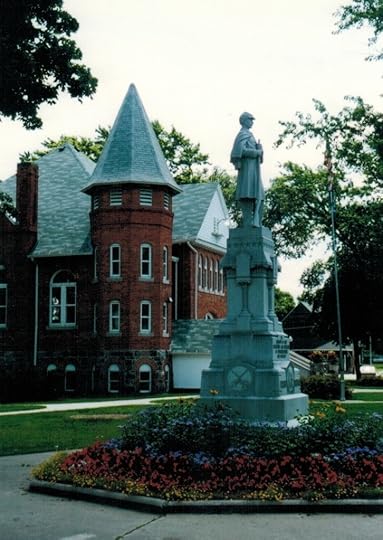
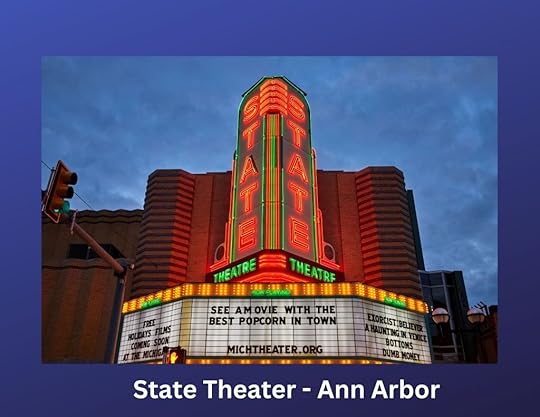
When I began my writing career, I spent hours studying the history of my adopted new rural area. I wrote for Florida Today magazine on the renaissance of the small-town theaters to revitalize the forgotten Main Streets of the state. Those theaters had once been the mainstay of towns across the country and when the railroads and highways drew people away from the downtowns of small communities, the demise of the theaters began the crushing despair for small town living.
In the past two decades I’ve enjoyed living in several small towns. One, outside Pittsburgh, is truly in decline. We lived in the rural area outside of Aliquippa, Pennsylvania, and spent more time in Pittsburgh than the abandoned steel mill town on the banks of the Ohio River.
For eight summers and falls, we lived in a small North Carolina town in the foothills of the Smokies. I didn’t have a large city nearby, but we were two hours from Atlanta, Chattanooga, Knoxville, and Asheville, so we had our choice in every direction.
I loved all the experiences. I still am fascinated by the origins, ups and downs, and renaissance of these small towns. Some of the time, I stumble upon them by accident when we decide to get off the highways and explore the backroads of this country. They provide a rich history populated with stories of pioneers and legends.
So, sit back and enjoy the small towns I’ve had the pleasure of visiting. And I’d love to learn more about your favorite places. Next week, I’ll take you to a special north Florida town that has seen its share of ups and downs.
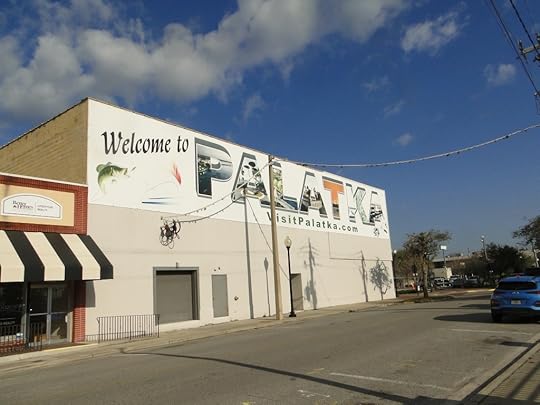
February 25, 2025
The Lighthouses of the Forgotten Coast of Florida

Florida’s Forgotten Coast – I almost hate writing about this section of Florida along the Gulf of Mexico coastline at the eastern start of the Panhandle. It is remote, beautiful, rural, and filled with small fishing villages that once thrived in the early days of Florida’s history.
Along the Highway 98, Florida’s coastal scenic road, sit four lighthouses–two in place for more than one hundred and fifty years; two moved/reconstructed to nearby locations for preservation. They are all worth the visit.
Photo from top left: St. Marks, Crooked River, Cape St. George, Cape San Blas.
St. Marks Lighthouse
I start at the most eastern of the four and the oldest. I am also most familiar with St. Marks because I have been visiting the St. Marks National Wildlife Refuge, where it’s located, since 2007 when I moved to Tallahassee. Three years ago, I began volunteering in the keeper’s quarters. Once entering the refuge, it’s an eight-mile, thirty-five mph, drive through wetlands, marsh and freshwater pools. Then suddenly, the lighthouse appears at the very end of the land jutting out into the bay.
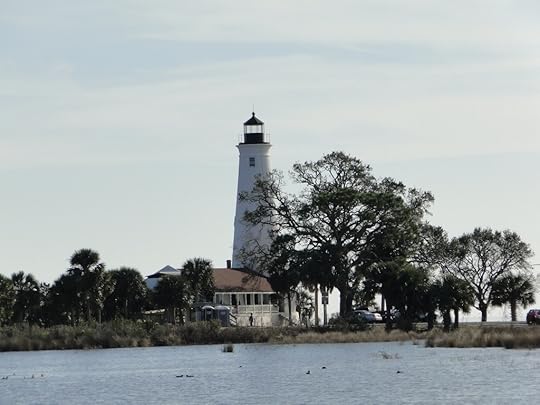
The original lighthouse, commissioned in 1828, was built on a strip of land called Cedar Point. It juts out into the Apalachee Bay and overlooks the Gulf of Mexico. However, the land started disappearing under the tower and eventually it had to be rebuilt in its current location with view of the first site. After destruction in a hurricane, its current tower was finished in 1842 has withstood the harshest of storms. Unlike other lighthouses, the keeper’s quarters are actually attached to the tower. Twice the quarters were destroyed by wave surge while the tower remained intact. During the Civil War, the quarters were burned down but the masonry tower remained tall. In 1867, someone had the bright idea of building the quarters out of limerock, bricks, and stones. The walls are four feet thick with wide window seats that would have been wonderful little nooks for children to play and read.
This lighthouse helped sea vessels find the St. Marks River in the town of St. Marks. Once a thriving port for transporting agricultural goods from the interior, today it is a small fishing village with a marina and two seafood restaurants. From there the two rivers flow out into the Gulf where the lighthouse stands guard to the east.
The tower is closed for climbing, unlike the other three on the Forgotten Coast, because the stairs are too narrow and the opening to the lens small. The Fresnel lens installed after the Civil War was removed in 2014 for safekeeping. It can be viewed at the U.S. Fish and Wildlife Service Visitor Center at the entrance to the refuge. However, three days a week, Friday-Sunday, visitors can walk through the four rooms of the quarters and take a step back to a simpler time when a family of ten lived with two bedrooms and an outhouse—a two-seater, no less.
Information: St. Marks National Wildlife Refuge, 850-925-6121. Fee to enter Refuge.

Crooked River Lighthouse
Sitting between Carrabelle and Carrabelle Beach, the Crooked River Lighthouse’s unique skeletal design overlooks the inlet between Dog Island and St. George Island, two important barrier islands to this section of the Gulf Coast. It was built in 1895 to take the place of the Dog Island Lighthouse that sunk into the Gulf waters in 1873 along with the keeper’s quarters. It sits near the deep Crooked River which flows into the Carrabelle River to the west and the Ochlocknee River to the east. The lumber industry was thriving and the lighthouse served as the guiding beacon for the eastern terminus of the Gulf coast’s Intercoastal Waterway.
At one time, folks thought Carrabelle would become a major port but instead Apalachicola to the west grew faster with more opportunity. Also, the lumber industry became waning, so the port became less important. However, it served the country during World War II as an amphibious assault landing training site at Camp Gordon Johnson. The lighthouse was eventually decommissioned in 1995. The city of Carrabelle took over the site in 2001 and today a replica of the keeper’s quarters serves as a museum.
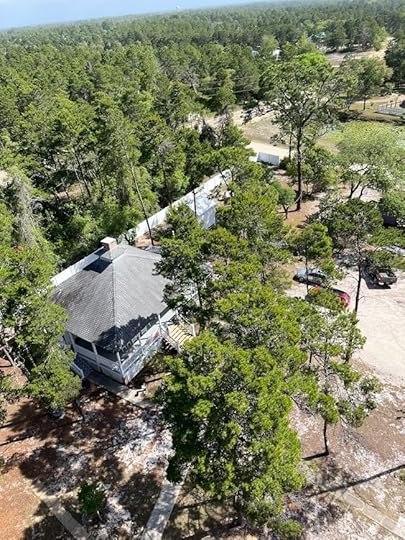

Visitors can climb the 103-foot structure—the tallest of the four lighthouses on the Forgotten Coast. It’s an easy climb but be prepared for a little hoisting up at the top to go out on the walk around. The view makes it worth the while.

Information: Crooked River Lighthouse Association 850-697-2732. Fee to climb.

Cape St. George Light
The story of this lighthouse involves a few miracles and lots of hard work by volunteers. The original tower, built in 1833 on Little St. George Island, had to be dismantled and reconstructed after storm damage in 1848, but it only lasted three years when it fell. Using the same materials, the lighthouse was reconstructed in 1853 further inland on the small island. Amazingly, this structure remained intact more than one hundred and fifty years guiding vessels to safety through Apalachicola Bay and beyond.
However, by 2005, it also collapsed because of the eroding shoreline. A sad occurrence but not the end of its story because a group of loving volunteers aided by the community of St. George Island and private and public funds brought it to life again—in the center of St. George. The volunteers salvaged more than 20,000 original bricks from the rubble left on Little St. George and rebuilt it along with a replica of the keeper’s quarters. It opened its doors in 2008. It’s an easy climb to the top and the quarters serve as museum and gift shop. Definitely worth the climb and visit.

Information: Cape St. George Light, 850-927-7745. Fee to climb.
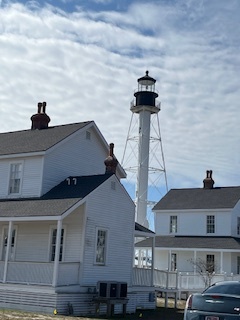
Cape San Blas Lighthouse
Finally! I visited the last of the Forgotten Coast lighthouses in early 2025 for the first time. Even though this lighthouse now resides in Port St. Joe, it once sat proudly on the little strip of land off the coast called Cape San Blas. Before it floated out to sea, it was rescued—just as it surely rescued ships needing guidance through many a dark night—by the city of Port St. Joe and brought to a park in the city center.
The two keeper’s quarters—one for the lighthouse keeper and another for the assistant keeper—did end up bobbing in the saltwater of the bay until rescued and brought ashore to serve as museum and gift shop homes.
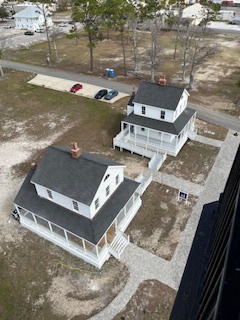

A story often told at the St. Marks lighthouse involves one of the keepers who had been transferred to St. Marks from Cape San Blas. The wife was not pleased with the lack of room and location of St. Marks. Seeing the two large keeper’s quarters of the Cape San Blas lighthouse, I can see why. The homes are separate from the skeletal lighthouse and quite spacious.
Built approximately one hundred thirty-five years ago, this lighthouse guided ships around the shoals that surrounded the cape. Its beacon could be seen ten miles out to sea. Tropical Storm Isaac in 2012 took away much of the lighthouse’s shoreline, so the city moved to a more protected site on St. Joseph Bay in 2014. Today it is a highlight of any visit to St. Port Joe. Visitors may climb the tower and enjoy breathtaking views of the bay and barrier strips of land that make up Cape San Blas and St. Joseph Peninsula.
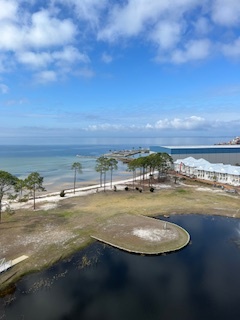
Information: Cape San Blas Lighthouse, 850-229-1151.
February 18, 2025
Lighthouse Passion

A dark and stormy night out on the seas with waves crashing the sides of the ship and cargo and crew slipping from port to starboard through the tumultuous waters threatened many a sailor and passenger with burial at sea as the ship neared shore and unknown dangers of a rocky coast and shallow sandbars loomed. And out of the dark, a light appears before the ship goes under and loses everything and one aboard.
In the days before navigational systems, seafaring folks depended mightily on the tall lighthouses shining and directing them to harbors, bays and inlets for safe passage inland. Long before electricity, those lanterns had to be kept lit all night long using whale oil or kerosene. Usually one man carried the load of fuel up the narrow winding stairs of the lighthouse. The “keeper” lived a hard yet essential life to the smooth arrival of cargo and passengers alike.
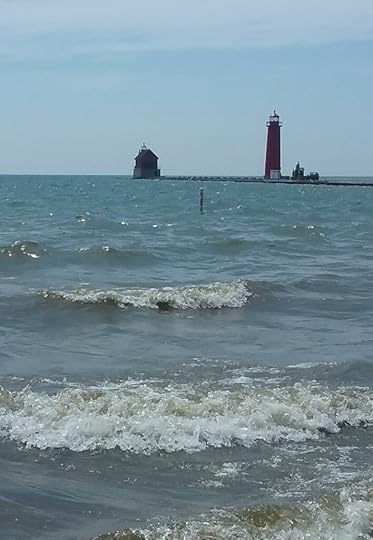
I have had a fascination with lighthouses from a young age. I grew up in Michigan—a peninsula of sorts surrounded on three sides by water. The Great Lakes—particularly Superior—were treacherous and frigid. At the age of ten, I visited the ocean for the first time when my family and I traveled to Montauk Point where the lighthouse sits on the edge of the Atlantic, and which miraculously has stood since 1796 after George Washington commissioned it in 1792.
Florida’s lighthouses haven’t had as long a history, nor have they been built on land as stable as Long Island. Yet, their stories provide a rich history of strength and resilience after thunderstorms, hurricanes, and attacks during a war where we turned on ourselves.
Here’s a peak at four of Florida’s lighthouses on what is known as the Forgotten Coast—near the Big Bend when the Florida peninsula narrows into the Panhandle.
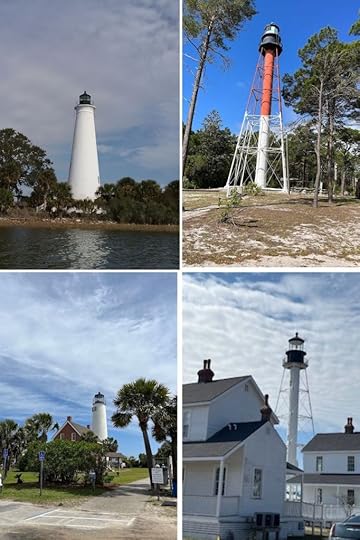
December 31, 2024
JIMMY, YOU WILL BE MISSED
I wrote the following blog post in February 2024 about my “brush” with President Jimmy Carter and Rosalynn Carter more than twenty years ago in Plains, Georgia. It’s still one of my bittersweet favorite stories.
When I learned of his passing two days ago, I retold the story. Then I remembered something else. Jimmy Carter changed my view of politics back in 1976. The presidential campaign of 1976 found me eligible to vote for the first time for President of the United States. Yet, on election day, I stayed home–in protest.
Two years of following the Watergate debacle while a college student left me disillusioned and disdainful of all politicians. It only worsened with the pardon of Richard M. Nixon by his successor, Gerald Ford. So, I didn’t vote the first year I was eligible.
As I watched the news one night shortly after Carter won the election, the reporters followed the President-elect as he arrived in Washington. The man, soon to be the most powerful person in the world, went to the trunk of his car, opened it, and pulled out his luggage and garment bag. Secret service hovered around him trying to help, but he brushed them off. Then he spoke to the cameras, flashing his big Georgia teeth when asked why he was carrying his own luggage.
“Well, who else should be carrying my bags?” he answered. Then slammed shut the trunk and moved away from the cameras.
Simple words and actions, but it stuck with me. I became a fan and cheerleader for everything Jimmy Carter. And I’ve never sat home on election day again. Not even for the primaries. He hooked me forever into believing in my country again.
Thank you, Mr. President. You left legacies small and large to the world. And those legacies are most needed today as I once again face a crisis of disillusionment.

Jimmy Carter received the Nobel Peace Prize in 2002 for his humanitarian work around the world. On a trip through Georgia late that year, we decided to make a detour through Plains, Georgia, to see the small town where President Carter and his wife still lived.
My travel companion–my now ex-husband–and I entered the small general store in the middle of downtown, which consisted of about two blocks of old-fashioned storefronts. We could have arrived in 1952 instead of 2002 except for the new flip phone residing in my pocket and two black SUVs parked at the curb outside the front door. Time had stopped in a good way for the home of the thirty-ninth president known as the peanut farmer with a colorful mother and outrageous brother.
The clerk behind the wooden counter greeted us warmly. “Welcome,” she said. “You’re in for a treat today. The monthly rotary meeting is going on in the back.” She pointed to a door at the rear of the store.
Not sure why that would be a treat for us, we smiled warmly and said we were excited to be there.
“Take your time and look around. The meeting will be over soon. If you stay long enough, you might get to meet the President and Rosalynn when they come out from the meeting. Those are the secret service vans out front.”
It seems that we chose our visit wisely to coincide with the Carters return from Geneva where he was awarded the 2002 Nobel Peace Award. They had come to the rotary meeting in their hometown so the leaders in Plains, Georgia, could offer up their own brand of pride and congratulations.
So, what else could we do but immerse ourselves into the store that had many shelves dedicated to the Carter presidency? Our daughter, a sophomore in college, had developed a strong interest in Carter and the work he was doing post-presidency. She hadn’t even been born until after his four years in the White House. I quickly put her on notice via my flip phone and kept the phone in my hand with her number up. I planned to tell Mr. Carter that my daughter was a fan and ask him to say hello to her via the phone.
Then we began our journey up and down the aisles intent on finding a souvenir to mark our visit. On the last aisle, furthest from cash register and front door, we found a six-pack of unopened Billy Beer, the beer made famous by Billy Carter, the untamed brother of Jimmy. My ex–an inveterate collector of ephemera–examined the cans and studied the price. He wanted to buy it, but I was reluctant. Seemed we could find a more appropriate way to remember President Carter.
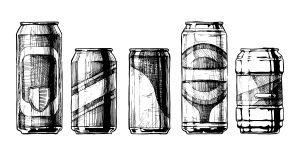
Several people suddenly pushed behind us in the aisle, but we were so intent in our discussion of the beer, we moved in closer to the shelves to allow them to pass without turning around. We were slightly annoyed that in the empty store, they had chosen our aisle to move through the store.
We finally decided upon a magnet for our refrigerator and took it back to the pleasant clerk at the front.
“Did you get to talk to him?” she asked with a lilt to her voice.
“Who?” I asked.
“President Carter and his wife. They passed right by you back there.” She pointed to the place where we’d been negotiating our souvenir choice. “There they go.”
We looked out the window and the two black SUVs we’d noticed earlier were pulling away from the store and headed down the road.
Because of our intense focus on something right in front of our noses, we missed the bigger picture. The beer fogged our attention, and we missed the opportunity to shake the hands of two people who stood for all that’s right with humanity.
Lesson learned and still learning. Focus may get the job done but if it causes us to lose sight of our surroundings whether it be natural beauty or people then we’ve sacrificed missing the important things in life.
In the twenty years since that day, I’ve learned that the moments we are engaged with all that teems around us give us the most reward. And it’s always good to be reminded.
Rest easy, Mr. President. May your passage be as peaceful as the rest of your life where you made a difference in the lives of millions. Your legacy through Habitat for Humanity and your other causes will continue to help others for many years to come. Thank you.



